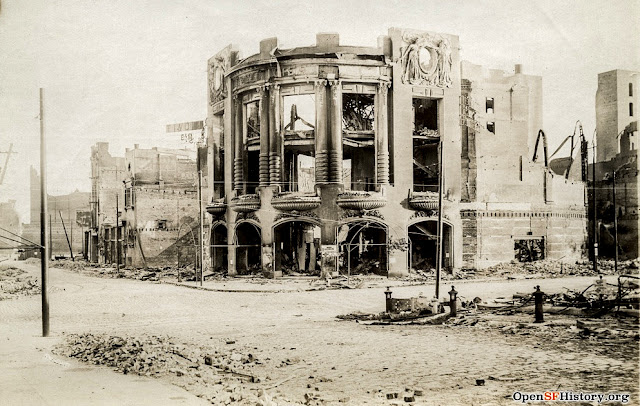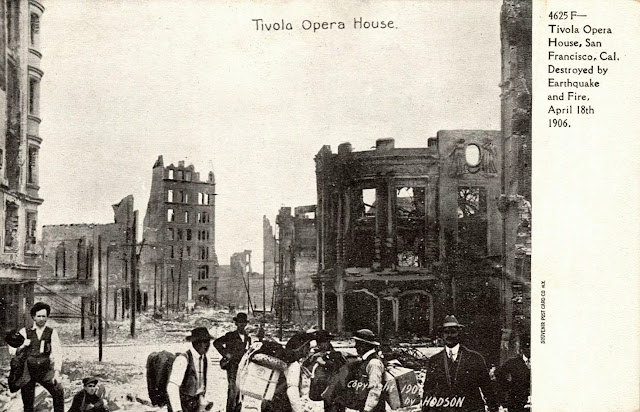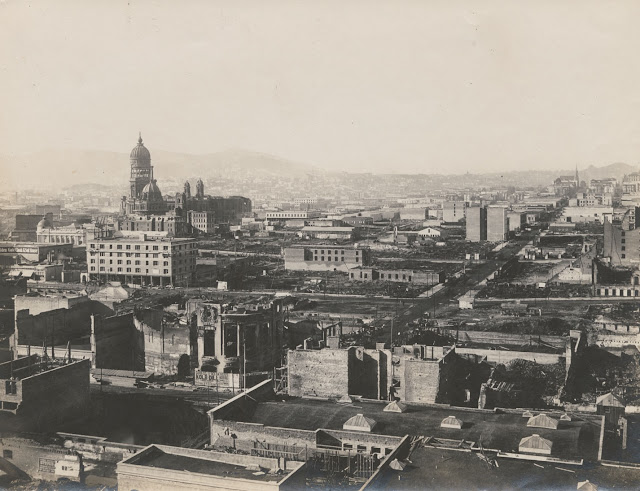SW corner of Mason and Eddy Streets | map |
The Tivoli pages: 1874-1879 Tivoli Gardens | 1879-1903 Tivoli Opera House - 30 Eddy St. | 1903-1906 Tivoli Opera House - Eddy and Mason | 1913-1951 Tivoli Opera House / Theatre - 70 Eddy
AS THE PANORAMA:
Opened: The building opened in 1884 with the panorama "The Battle of Waterloo," a painting by Joseph Bertrand and Lucien Sergent, of Paris.
The "Waterloo" program's page about the building. Thanks, Glenn!
Another promotional item for the "Vicksburg" attraction that was located by Glenn.
In the 1894 directory it's listed again the Peoples Palace. The directory's listing for the theatre in 1895 noted that the Peoples Palace Music Hall was "now Circus Royal and Venetian Water Carnival." In the 1896 directory listing the circus and water carnival are gone but they noted that the Peoples Palace Amusement Co. was the proprietor with Cliff Phillips as manager. "Music Hall" had been dropped from the name. 1897 was the last listing for Peoples Palace.
In the 1898 directory the building was listed as the Olympia Music Hall. The 1899 listing added that Albert Walterstein was managing, still around from the initial Peoples Palace days.
A 1901 program for the Olympia,"San Francisco's Great Music Hall." The program is on Calisphere from the Museum of Performance and Design Performing Arts Library. Inside: "Beginning Monday evening, July 15, 1901 every evening and Sunday afternoon Hungarian Orchestra under the direction of the famous violinist, Isidore Fenster and a superb company of specialty artists. Publishers, Horwinski Bros."
The 1901 city directory, in addition to listing the Olympia Music Hall, added a listing for the Olympia Amusement Co. 1902 is the final listing for the Olympia.
The building got another rebuild and reopened as the Tivoli Opera House on December 23, 1903. It was a larger and more opulent replacement for the Tivoli Opera House at 30 Eddy St.
In this 1905 San Francisco Public Library view we're looking north on Mason from Market. Up at the first corner (Eddy St.) note, on the left, the roof of the circular building that had become the Tivoli Opera House. Mark Ellinger noted:
A March 1905 photo looking up Mason St. from Market with "The Burgomaster" playing at the Tivoli, over on the left at Eddy St. It's a photo from a private collector that appears on the Open SF History Project website. Thanks to Jack Tillmany for spotting it.
A 1906 UC Bancroft photo with "Miss Timidity" on the sign, a "musical eccentricity" starring Cecelia Rhoda that had opened April 2. Thanks to Art Siegel for researching the production. He found items about the show in the S.F. Call issues of March 29 and April 3. They can be viewed via the California Digital Newspaper Collection.
Mark Ellinger noted that across Eddy St. from the Opera House was the mansard-roofed Golden State Hotel with Spider Kelly’s saloon on the main floor. Behind the hotel was the Techau Tavern. He adds:
"When director W.H. Leahy took charge of the house in 1890, he began producing Italian opera four months of the year with companies he recruited from small opera houses in Italy. In 1903 he built a new Tivoli Opera House around the old Panorama Building on the southwest corner of Mason and Eddy, where now stands the Ambassador Hotel.
"While traveling in Mexico late the same year, Leahy heard soprano Luisa Tetrazzini singing with an itinerant Italian opera company in Mexico City. Leahy engaged the entire company and in 1904 they opened the new opera house with 'Rigoletto.' Singing the part of Gilda despite a cold, Mme.Tetrazzini became an immediate sensation. For the next two years her many performances at the Tivoli packed the house to overflowing and Luisa Tetrazzini became a star of international repute."
Closing: The Tivoli was destroyed in 1906 by the April 18 earthquake and fire.
Status: The location is now the site of the
Ambassador Hotel, a building that was supposed to have a theatre -- but
the theatre part never got built. See the page about the Ferris Hartman Theatre.
A "Tivola" Opera House postcard view by Hodson. Thanks to Art Siegel for spotting this one when it came up on eBay. He notes that left of center in the distance we can see the white column of the Native Sons (Admission Day) monument.
The post earthquake ruins as we look up Mason St. toward the ruined Fairmont Hotel on Nob Hill. A bit of Tivoli signage is visible on the left. That 6 story building on the right, at the NE corner of Mason and Eddy, housed the Poodledog Restaurant. The building survived, after a fashion -- it lost several stories off the top. The UC Bancroft Library photo appears with Mark Ellinger's Up From the Deep article on the Tenderloin.
A superb look at the Tivoli ruins from above (center left) with the damaged City Hall beyond. Straight ahead up toward the upper right it's Eddy St. heading west. In the foreground is Mason St. Take a left to get to Market, right would get you to Nob Hill. It's a California Historical Society photo on Calisphere. On that site click on the image once to get a larger view, then click again for another increase in size -- then you can pan around.
A corner view of the ruins of the 3rd Tivoli taken by Bear Photo that's in the UC Bancroft Library collection. The photo is also in the California State Library collection. A similar shot is on Calisphere from the California Historical Society.
A detail of the corner from the California Historical Society is on Calisphere. There's also a closer look at the lower portion of the corner from CHS.
A view of the Eddy St. side of the corner appearing on the Online Archive of California from the California
Historical Society, where they mistakenly label it as at Mason and Ellis. There's also a copy from the California State Library on Calisphere. A more closely cropped shot from this angle from the Museum of Performance and Design Performing Arts Library appears on Calisphere.
A wider look at the Eddy St. side of the building. On the left there's a view down Mason to the Native Sons monument at Market St. Thanks to Bob Ristelhueber for locating the photo in the UC Berkeley Bancroft Library collection for a post on the BAHT Facebook page.
The Tivoli in the Movies: Jack Tillmany comments that in "San Francisco" (MGM, 1936) Jeanette MacDonald sings the title song "...at the Chickens Ball, on the Barbary Coast, just prior
to the earthquake. Previously we had seen her at the Tivoli Opera House,
with a pretty accurate night image of the facade to introduce
that sequence."
MGM's version of the Tivoli Opera House 52 minutes into "San Francisco." Thanks to Jack Tillmany for the screenshot. He notes: "Obviously, it's a matte shot, but it's only on the screen for a couple seconds, so gets the job done."
It's unknown where MGM got their image of the building as there seem to be no decent views that have surfaced of the theatre prior to the earthquake. A clip of Jeanette MacDonald singing "San Francisco" is on YouTube.
More information: See the pages on the Tivoli Gardens, the 1879 Tivoli Opera House and the 1913 Tivoli Theatre.
An early panorama exhibition was the painting "Paradise Lost" shown at the Eureka Theatre in 1865, accomplished by having it or rollers so it slowly moved across the stage. A Tent Panorama on Market St. at City Hall Ave. exhibited "The Battle of Gettysburg" in 1886. The Panorama Building at 10th and Market exhibited "The Storming of Missionary Ridge" beginning in 1887 and then a different version of "The Battle of Gettysburg." One attraction at the 1894 Midwinter Fair was the panorama "Kilauea Volcano." And we had another panorama that was converted into a theatre. The building at 8th and Market that had exhibited the "Battle of Manila Bay" panorama was rebuilt to become the Central Theatre in 1900.
Several versions of the "Siege of Vicksburg" panorama are discussed on a HistoryNet page "Vicksburg in the Round."
Jack Tillmany's Arcadia Publishing book "Theatres of San Francisco" can be previewed on Google Books. It's available from Amazon or your local bookseller.
| back to top | San Francisco Theatres: by address and neighborhood | alphabetical list | list by architect | pre-1906 theatre list | home |



































PANORAMA FOR A SMALL CITY: Histories of a Mass Medium
ReplyDeleteI am writing the first spreadsheet from the American point of view about 19th century rotunda panoramas. These were the biggest paintings in the world, 50 x 400=20,000 square feet, housed in their own rotundas which were 16-sided polygons. Chicago in 1893 had 6 panorama companies and 6 panorama rotundas.[]On September 18,2003 I found in the display case of Milwaukee County History Museum the F.W.Heine diaries, which commence 1860 and conclude upon Heine's death 1921.These are the ONLY KNOWN narrative of a panorama company, that of William Gottlieb Wehner(1847-1928) of Chicago-Milwaukee AND SANTA CLARA COUNTY . Wehner lived in Chicago and built his panorama studio in downtown Milwaukee.From 1885-88 he produced two units of BATTLE OF ATLANTA, 2 units of MISSIONARY RIDGE & LOOKOUT MOUNTAIN and 3 units of JERUSALEM ON THE DAY OF THE CRUCIFIXION. The diaries needed to be transcribed in German, translated to English, scanned to computer. Michael Kutzer, born 1941 in Leipzig like Heine, is translator. The project received a $50,000 grant from The Bradley Foundation of Milwaukee.INFO TO SHARE Gene Meier 1160 Bailey Road, Sycamore, Illinois 60178 815 895 4099 genemeier@frontier.com